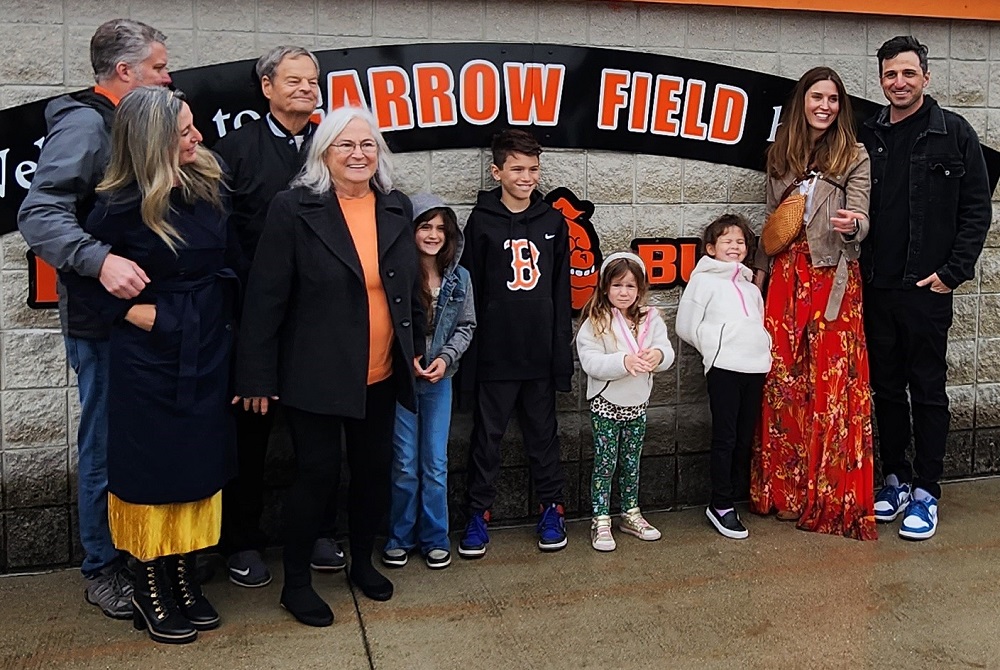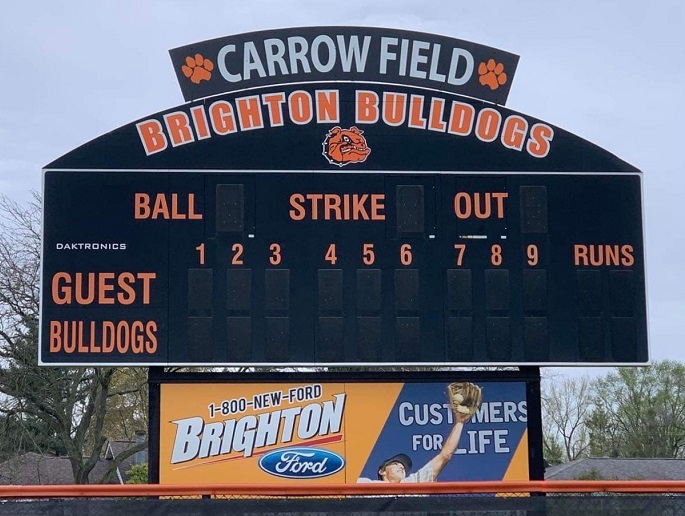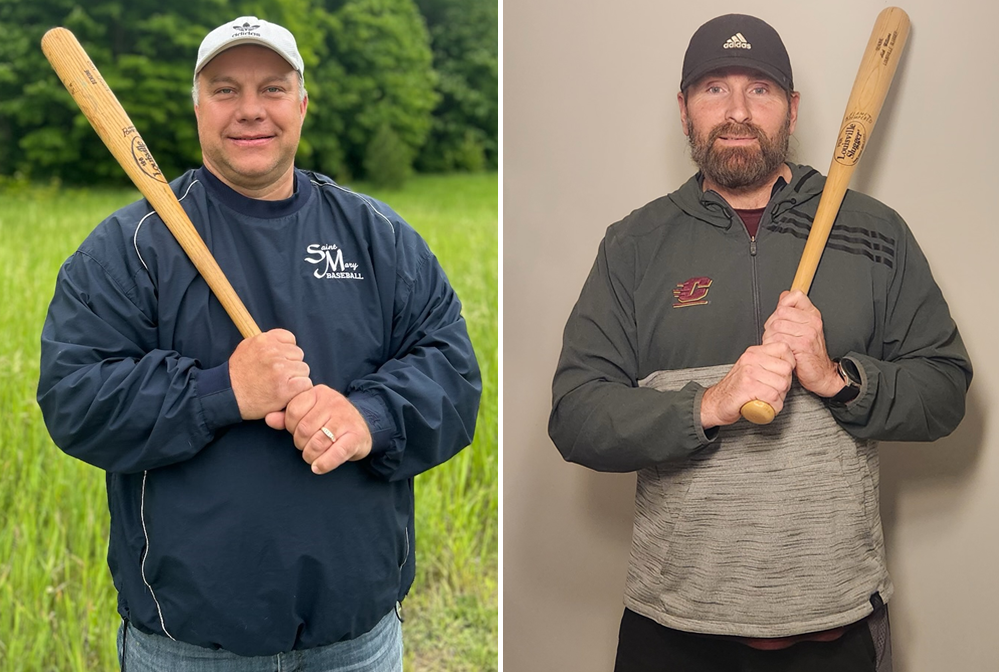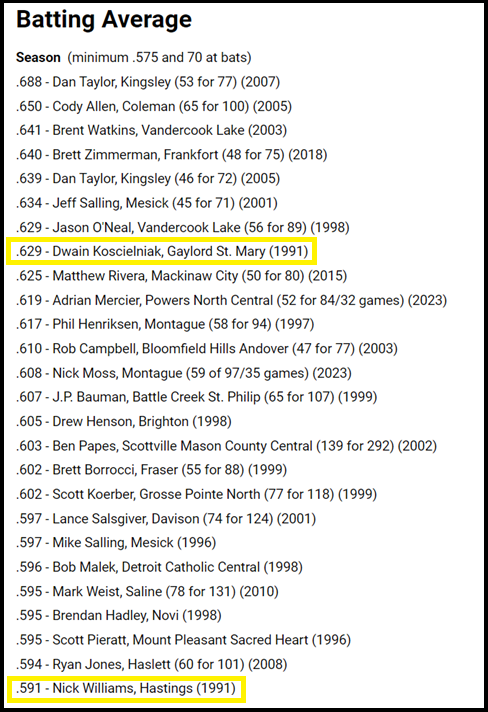
Brighton Names Baseball Field for Program Builder, Longtime Leader
By
Tim Robinson
Special for MHSAA.com
May 4, 2023
BRIGHTON — Mark Carrow didn’t know what to expect April 22 when he arrived at Brighton High School’s baseball field, where he was the guest of honor for a ceremony officially naming it Carrow Field.
 “I remember back in October, when they announced this would happen, I told my wife, Mary, that there will be probably 60-70 people here, because there are 18 players on each team and their parents,” he recalled. “We pulled up here and there were all these people, and these young men who look older now.”
“I remember back in October, when they announced this would happen, I told my wife, Mary, that there will be probably 60-70 people here, because there are 18 players on each team and their parents,” he recalled. “We pulled up here and there were all these people, and these young men who look older now.”
Dozens of Brighton alumni, some of whom Carrow hadn’t seen since their high school days nearly a half-century ago, were in attendance for the ceremony held before a doubleheader with Ypsilanti Lincoln.
Carrow retired in 2006 after 34 seasons as Brighton’s baseball coach, recording 823 wins, now eighth on the state’s all-time list. He also was an assistant football coach and coached both boys and girls middle school basketball.
He came to Brighton a year after graduating from the University of Michigan, where he played baseball for the Wolverines, starring at third base.
“My dream was to coach baseball at Ann Arbor High,” Carrow said of his high school alma mater, now Ann Arbor Pioneer. “That was my dream.”
But he had applied to Brighton Area Schools as well, and after a year teaching in Grand Rapids, he and Mary both were offered teaching positions.
“Wouldn’t you know it? We were in school for two days and Ann Arbor calls me up,” Carrow said. “They had a phys ed job open. I’d have been the JV football coach, and I knew the baseball coach was on his way out. It was everything I wanted, and I went to (administrator) Bob Scranton and said, ‘Here’s what’s happening.’ He told me to think about it over the weekend and come back Monday.
“My wife and I talked it over, and we were so grateful to Brighton for giving us a chance to be near our hometown that we felt we owed them a year,” Carrow said. “In November, we bought a house that we lived in for 22 years.”
Brighton’s sports teams weren’t the dominant squads of today. The football team had had two winning seasons in 20 years, and the year Carrow arrived went 0-9.
“We played in six homecoming games, including our own,” he said. “Everyone wanted to play us.”
The baseball team wasn’t much better, having gone decades without a winning season.
But the Bulldogs were 12-12 that first spring under Carrow’s leadership, and never finished below .500 during the rest of his tenure.
 The Bulldogs joined the Southeastern Conference the next year and got off to a 7-0 start before losing at Lincoln.
The Bulldogs joined the Southeastern Conference the next year and got off to a 7-0 start before losing at Lincoln.
“The kids were crying on the bus ride home,” Carrow said, “and I knew right then that Brighton had turned a corner, that it meant something to win and losing wasn’t acceptable anymore.”
Brighton took off, winning 20 games or more in all of his last 23 years as a coach, and a total of 13 league titles, 12 District titles, three Regional crowns and while making two trips to the Semifinals.
The talent was there, too, including 16 all-state players and two Mr. Baseball Award winners in Ron Hollis and Drew Henson.
Carrow earned national and Michigan Coach of the Year honors three times apiece and was inducted into the Michigan High School Baseball Coaches Hall of Fame in 1992.
The field was renamed in his honor after the Brighton school board changed its policy to allow the renaming of facilities to honor living persons less than two years ago.
But Carrow is quick to cite the reasons for his success.
“The players are the ones who made this possible,” he said. “I mean that from the bottom of my heart. I never threw a pitch or hit the baseball. I got 800 wins, but it was because of them.
Carrow has a photographic memory, which came in handy while chatting with former players.
“It was funny, because with each kid I remembered an incident about them,” he said. “Jeff Bogos, who I hadn’t seen since he graduated in 1979, came out and I said, ‘Do you remember when we were at Milan and your knee went out (of place) in the middle of the field?’ It happened twice. He said, ‘How do you remember that?’ And I said, ‘How could I not?’”
Carrow moved to Florida after his retirement, where he and his longtime assistant, George Reck, meet up a couple of times a week. He makes frequent trips north to watch U-M football and to visit his son, Chris, who lives in Chicago.
Baseball is firmly in his past.
“I think I’ve been to one high school game since I went down there,” Carrow said. “I hated the way the coach was coaching, and Mary did, too. She said, ‘We don’t have to watch any more high school baseball,’ and I said, ‘You’re right.’”
When he retired, Carrow said he would likely be forgotten in a few years.
Seventeen years later, his legacy is assured and his memory will be invoked any time one looks at the scoreboard in left-center field that has a “Carrow Field” sign on top of it.
Not bad for a coach who was in the right place at the right time.
“My dream was fulfilled, and rightly so,” Carrow said. “And, believe me, I made the right decision. I couldn't have had better kids to teach or lived in a better community. It couldn't have worked out any better.”
PHOTOS (Top) The Carrow family stands together in front of the welcome sign to Carrow Field – including daughter Tiffany (front left), Mark and Mary (second from left, front and back) and son Chris (far right). (Middle) The Carrow name stands tall atop the scoreboard at the field named for the longtime coach. (Family photo by Daniel Collins.)

Similarities Tie Slugging Pair's 1991 Pursuit of .600 Average, Paths After
By
Steve Vedder
Special for MHSAA.com
June 11, 2024
They both remember chasing the identical goal 33 years ago.
It wasn't so much that Hastings' Nick Williams and Dwain Koscielniak of Gaylord St. Mary were aware in 1991 of becoming the first MHSAA-recognized .600 hitters in state history. What the two remember most about their magical final high school seasons has little to do with records, but simply closing out outstanding baseball careers with a bang.
"I think it was the same scenario for both of us," Williams said. "You just want to get a hit, drive the ball every time you're up."
It may be forgotten now, but in an era where tracking batting averages wasn't as simple as inserting a thumb drive and a couple clicks on a laptop, it's easy to see how the one-of-a-kind hitting exploits of Williams and Koscielniak may be overlooked. For instance, with just days left in their senior seasons neither knew they were closing in on the state record for batting average of .577 by Greg Atkinson of Maple City Glen Lake in 1985. The two were more focused on helping their teams win District titles and then beginning their summers.
About all the pair really knew was that magical seasons were about to end. Both were batting over .600, but when ballplayers are hitting that well, there's a fine line in maintaining such rare territory. As both found out – one painfully so and the other happily – every at-bat is critical. Koscielniak wound up slugging a pair of homers in his final game to finish with a .629 mark while Williams, who started the last day of his senior season with a hefty .612 mark, went hitless for the first time all spring to finish at 591.
While the chase to hit .600 is obviously an entertaining story, it's only the tip of the iceberg in terms of the amazing parallels between the lives of Koscielniak and Williams, who lived 170 miles apart growing up in Gaylord and Hastings, respectively.
Both, for example, were outstanding dual-sport athletes. Koscielniak graduated second on the Michigan football career rushing list with 5,078 yards from 1987-90, and he still owns the state single-game record of 529 yards against Pellston on Oct. 26, 1990. Williams, meanwhile, averaged 24 points per game as a senior in basketball and could have been a dual-sport athlete at the next level if not for sticking with baseball.
In addition, both went on to stellar collegiate careers. Williams was a second-team all-Mid-American Conference selection in 1995 as a junior, and Central Michigan University captain as a senior. Koscielniak played two years at Mott Community College before becoming a slugging catcher/infielder at Ferris State. He was named Player of the Year in the Great Lakes Intercollegiate Athletic Conference in 1994 when he won the league’s triple crown hitting .403 with nine home runs and 37 RBIs.
 Both had flirtations with pro ball as Williams was taken by the Seattle Mariners in the 48th round of the 1991 MLB draft and later drew interest from Boston and Cincinnati following his time at CMU. Koscielniak was drafted by San Diego in the 32nd round in 1994 and reached High-A a year later. He batted .261 with 32 RBIs in 64 games over two minor league seasons.
Both had flirtations with pro ball as Williams was taken by the Seattle Mariners in the 48th round of the 1991 MLB draft and later drew interest from Boston and Cincinnati following his time at CMU. Koscielniak was drafted by San Diego in the 32nd round in 1994 and reached High-A a year later. He batted .261 with 32 RBIs in 64 games over two minor league seasons.
Koscielniak and Williams, who unknowingly played against each other with their college teams in 1994, also both wound up in athletics after college. Williams became an associate athletic director at Central Michigan, while Koscielniak coached baseball at Gaylord St. Mary.
There's more as both players are fathers of college-level talents. Williams' daughter Jayden ran track at Central Michigan while another daughter, Taryn, is playing volleyball at Delta College. Koscielniak's sons Steven and Christopher both played baseball at Delta College, daughter Brooke is an equestrian at Saginaw Valley State, and youngest son Brett is a three-sport athlete at Gaylord St. Mary.
If there's one more nugget which Williams and Koscielniak have in common, it’s that both credit long hours of work for becoming outstanding hitters. Williams would use a tarp in the family garage for a makeshift hitting cage, while Koscielniak's offseason hitting quarters was a cage stuck away in a pole barn. Both said they would never have approached being .600 hitters without putting in loads of extra time.
"I got my swings in several times a week in the offseason, and that really helped me," said Koscielniak, whose professional career received its earliest spark when a Ferris State science teacher/part-time MLB scout wandered past the school's gymnasium and noticed Koscielniak practicing throws to second base from his spot as catcher during winter workouts.
Williams remembers getting in about 200 at-bats with summer travel teams in Hastings, Grand Rapids and Battle Creek between his junior and senior years.
"I had a lot of success as a hitter because I put the time in," said Williams, who remembers half a dozen scouts at every Saxons game as a senior. "I didn't play a fall sport, and I put in a lot of time just hitting. I became aware of being able to hit the ball the other way, and I think my confidence began to grow."
As for approaching the .600 mark during their final seasons, Williams and Koscielniak said they were blissfully unaware of any state batting records. Williams does recall never considering trying to preserve a .600 average by taking a game off down the stretch.
"No, I never (had) a thought of that – not even a conversation," he said. "A lot of time has passed since then, but I don't remember sitting out at all. No way. I was always going to play, and that's it."
Koscielniak also doesn't recall worrying about hitting 600. While Koscielniak was the first .600 hitter in state history, only 17 others have gone on to become MHSAA-recognized .600 batters. Dan Taylor of Kingsley holds the state record for highest average with a .688 mark in 2007.
Koscielniak also hit 17 home runs as a senior and finished his career with 35, which continues to rank eighth on that statewide all-time list.
"Back then if you loved the game, you just played. How it turned out for me is how it turned out," he said. "I was competitive and played hard. I played well at Mott and then Ferris State, and the door opened up for me a little."
Williams and Koscielniak remember one huge drawback in trying to hit .600: walks. Pitchers would simply not give them anything to hit. Williams remembers a doubleheader against Coldwater where he hit home runs in his first at-bats in both games, then received two intentional walks in both games. Koscielniak's two homers in his final game were followed by two intentional walks.
Such a stingy pitching philosophy was par for the course, they say.
"That becomes very difficult for a hitter," Williams said. "You have to be dialed in when you get your opportunities. It was a fun year for me, but a struggle at times because (the walks) make you feel like you're not doing your job for the team.
"I don't think hitting .600 was a big deal. We didn't talk about stats and those things. You keep track a little, but I had no idea till the end of the year. And in the end, it's not about stats. I loved playing baseball."
These days, Williams is an instructor as part of the physical education and sport faculty at CMU, teaching courses on professional and collegiate athletics. Koscielniak is an operation manager for Schwan’s Food Service and with his wife Liz owns the Gaylord Equestrian Center.
PHOTOS (Top) Dwain Koscielniak, left, and Nick Williams stand for recent photos; they were the state’s top high school hitters in 1991 as both pursued a .600 batting average. (Middle) They continue to rank among the elite on the MHSAA record book list for top batting averages for a single season. (Photos courtesy of Koscielniak and Williams.)

